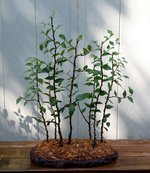Pepibom
Sapling
Greetings all,
I have recently started growing my own forest material (Trident) I have a variety of material in the works including cuttings, whips and some 2-3 yr old stuff.
I am curious to know if you all have a certain approach to growing forest material? Do you let things just grow out for years before cutting back? Are you trimming the tops or the side branches out every season? Are you planting your planting your forests as young clumps right from the start in grow pots or do you develop separate trees and place/arrange them later?
As discussion “fodder” I am attaching a pic of a forest clump in a nursery pot and also of a smaller trident forest I recently saw in an auction. What approach would one take to creating a little forest like that??
A chalupa of questions here; appreciate your contributions for any of them
I have recently started growing my own forest material (Trident) I have a variety of material in the works including cuttings, whips and some 2-3 yr old stuff.
I am curious to know if you all have a certain approach to growing forest material? Do you let things just grow out for years before cutting back? Are you trimming the tops or the side branches out every season? Are you planting your planting your forests as young clumps right from the start in grow pots or do you develop separate trees and place/arrange them later?
As discussion “fodder” I am attaching a pic of a forest clump in a nursery pot and also of a smaller trident forest I recently saw in an auction. What approach would one take to creating a little forest like that??
A chalupa of questions here; appreciate your contributions for any of them
















